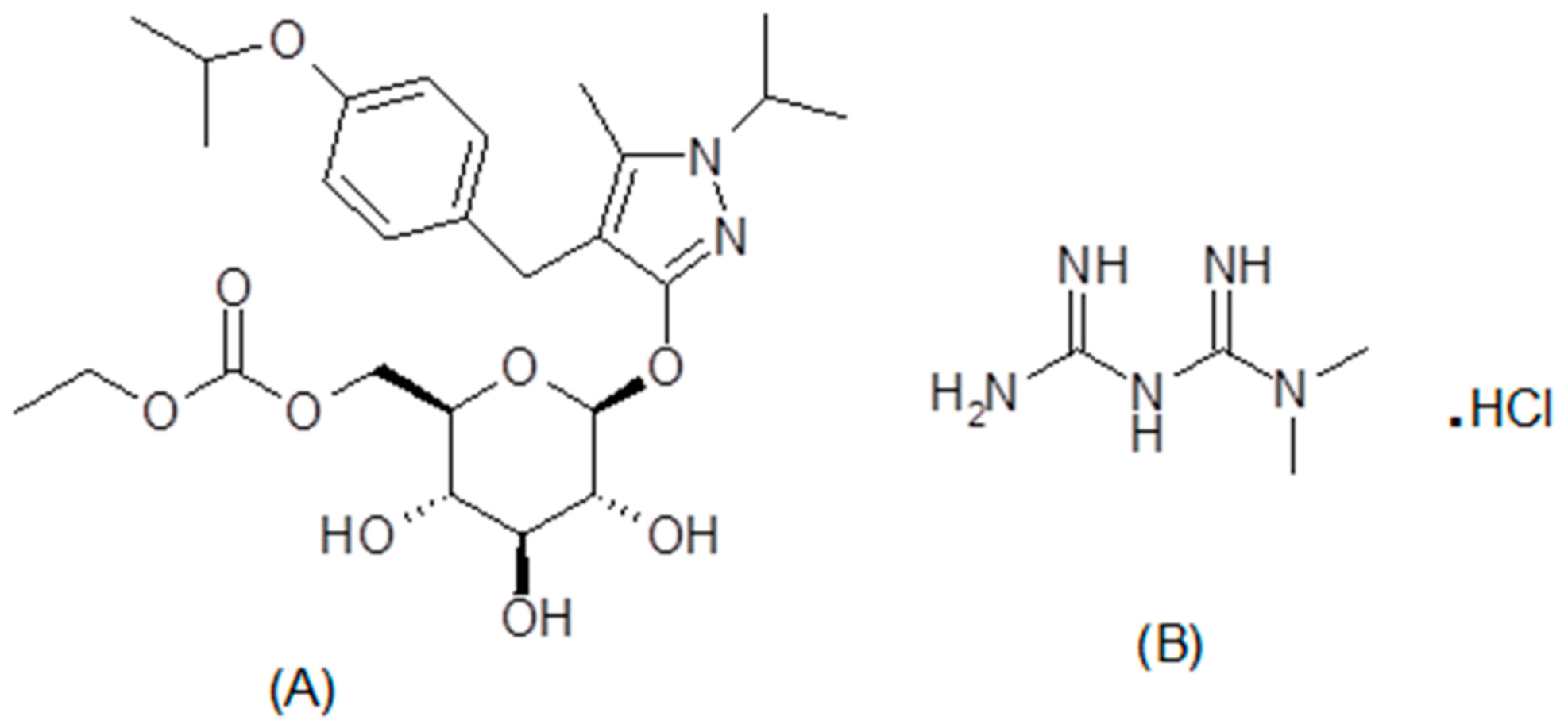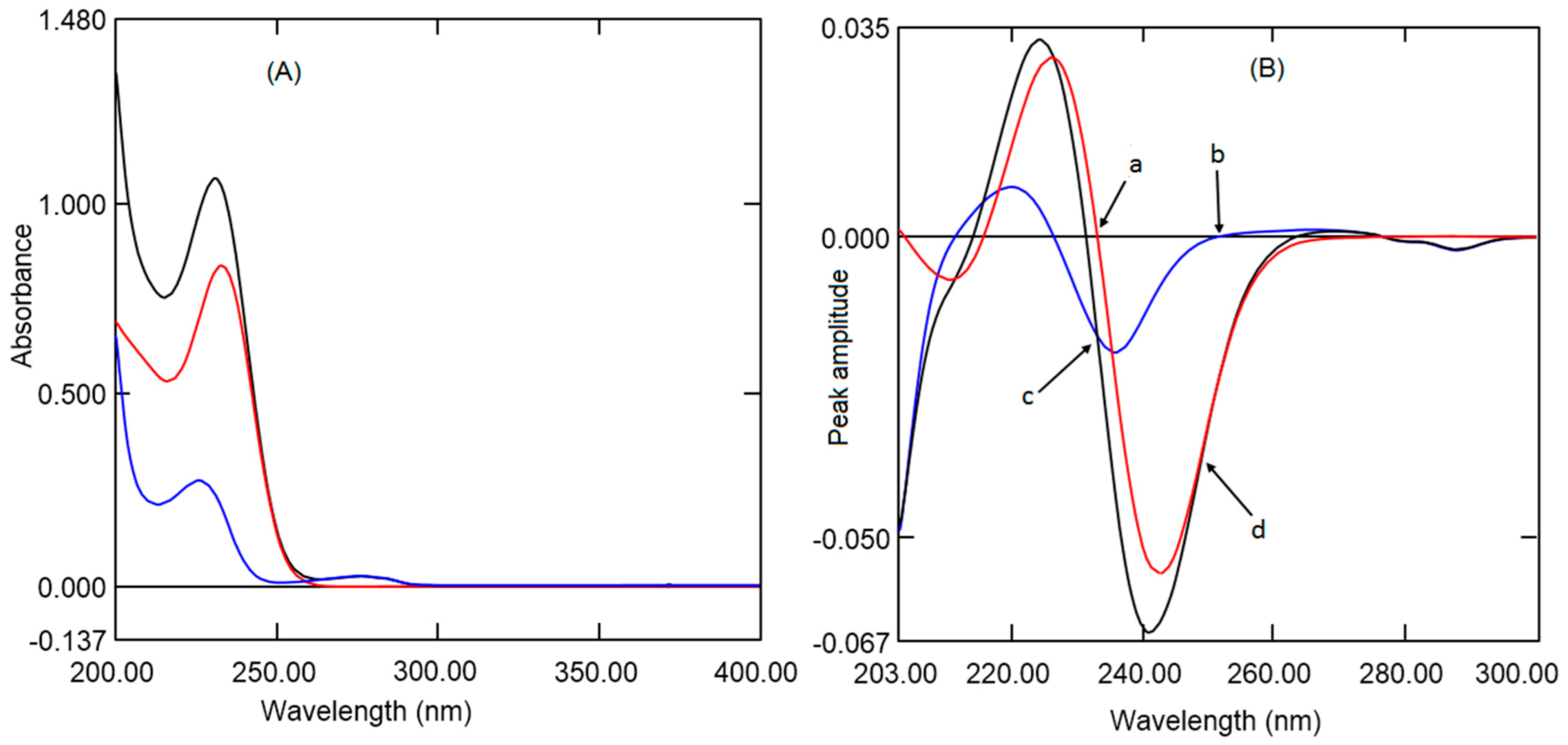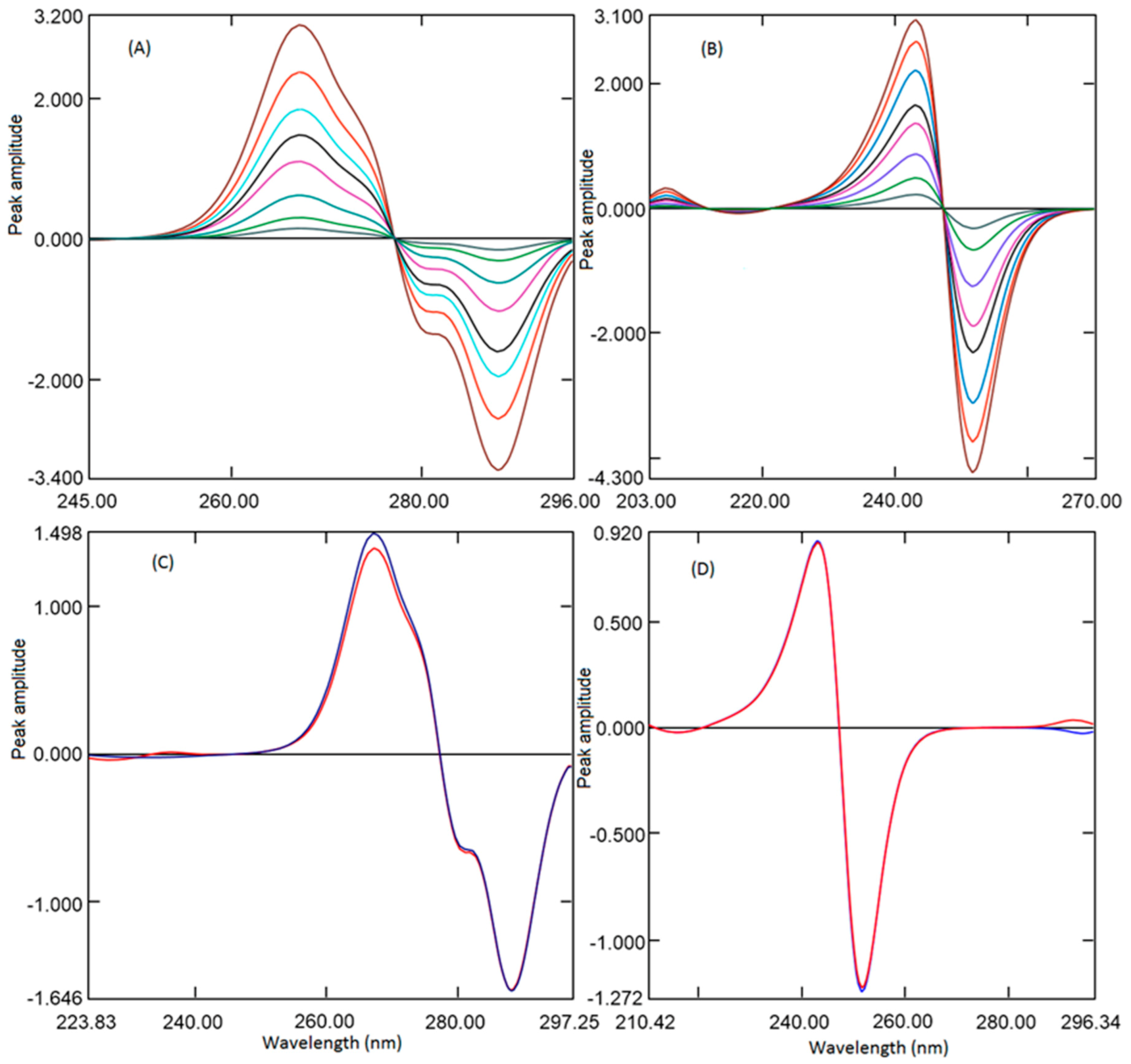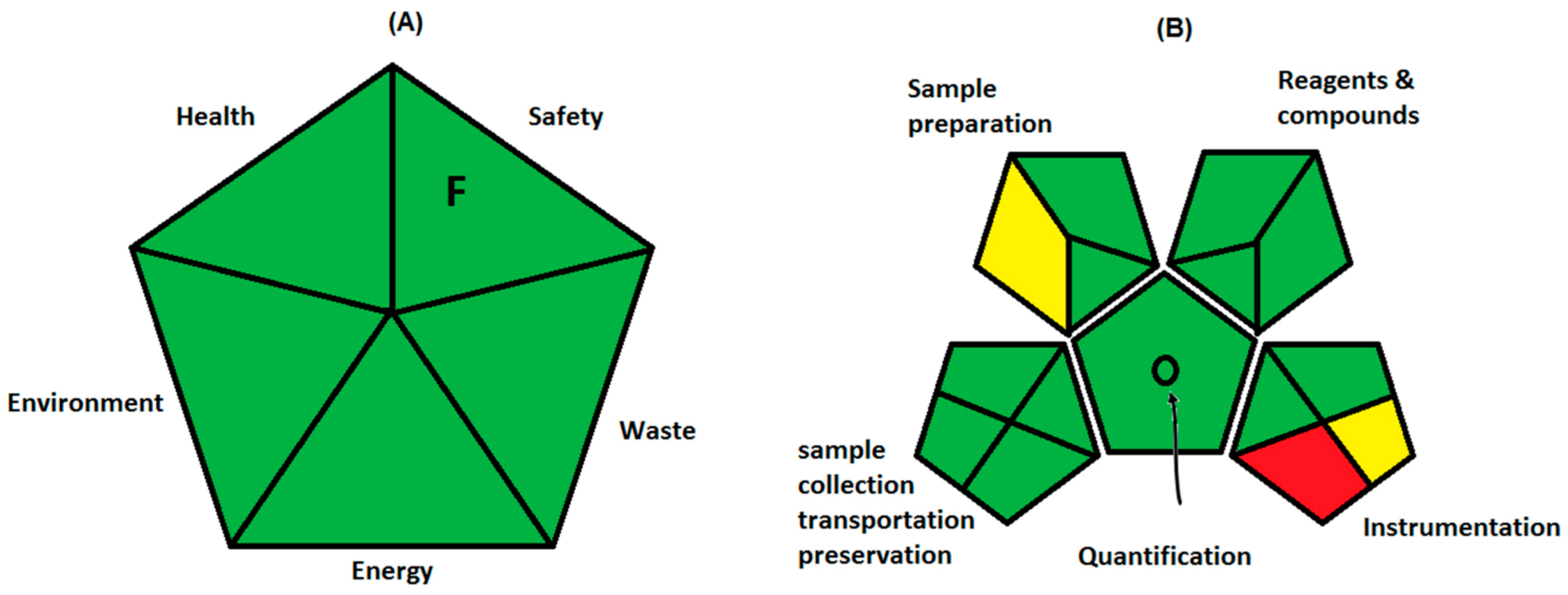Development and Validation of Green UV Derivative Spectrophotometric Methods for Simultaneous Determination Metformin and Remogliflozin from Formulation: Evaluation of Greenness
Abstract
:1. Introduction
2. Materials and Methods
2.1. Chemicals and Reagents
2.2. Instrument and Software
2.3. Preparation of Standard Solutions
2.4. Preparation of Sample Solutions and Laboratory Mixed Solutions
2.5. Procedure
2.5.1. First Derivative Spectroscopic Method (FDS)
2.5.2. Ratio Absorbance Difference Method (RAD)
2.5.3. Ratio First Derivative Method (RFD)
2.6. Application of Spectroscopic Methods to Formulations and Laboratory Mixed Solutions
3. Results and Discussion
3.1. First Derivative Spectroscopic Method (FDS)
3.2. Ratio Absorbance Difference Method
3.3. Ratio First Derivative Method (RFD)
3.4. Method Validation
3.4.1. Linearity
3.4.2. Limit of Determination and Quantification
3.4.3. Accuracy and Precision
3.4.4. Selectivity
3.4.5. Stability Studies
3.4.6. Determination of REM and MET in the Formulation and Standard Addition Method
3.5. Greenness Evaluation of the Proposed Methods
4. Conclusions
Supplementary Materials
Author Contributions
Funding
Institutional Review Board Statement
Informed Consent Statement
Data Availability Statement
Acknowledgments
Conflicts of Interest
References
- Zheng, Y.; Ley, S.H.; Hu, F.B. Global aetiology and epidemiology of type 2 diabetes mellitus and its complications. Nat. Rev. Endocrinol. 2018, 14, 88–98. [Google Scholar] [CrossRef] [PubMed]
- Saeedi, P.; Petersohn, I.; Salpea, P.; Malanda, B.; Karuranga, S.; Unwin, N.; Colagiuri, S.; Guariguata, L.; Motala, A.A.; Ogurtsova, K.; et al. Global and regional diabetes prevalence estimates for 2019 and projections for 2030 and 2045: Results from the International Diabetes Federation Diabetes Atlas, 9th edition. Diabetes Res. Clin. Pract. 2019, 157, 107843. [Google Scholar] [CrossRef] [PubMed] [Green Version]
- Waugh, N.; Cummins, E.; Royle, P.; Clar, C.; Marien, M.; Richter, B.; Philip, S. Newer agents for blood glucose control in type 2 diabetes: Systematic review and economic evaluation. Health Technol. Assess. 2010, 14, 25–33. [Google Scholar] [CrossRef] [Green Version]
- Scheen, A.J. Pharmacodynamics, Efficacy and Safety of Sodium–Glucose Co-Transporter Type 2 (SGLT2) Inhibitors for the Treatment of Type 2 Diabetes Mellitus. Drugs 2015, 75, 33–59. [Google Scholar] [CrossRef]
- Choi, C.-I. Sodium-Glucose Cotransporter 2 (SGLT2) Inhibitors from Natural Products: Discovery of Next-Generation Antihyperglycemic Agents. Molecules 2016, 21, 1136. [Google Scholar] [CrossRef] [Green Version]
- Mohan, V.; Mithal, A.; Joshi, S.R.; Aravind, S.R.; Chowdhury, S. Remogliflozin Etabonate in the Treatment of Type 2 Diabetes: Design, Development, and Place in Therapy. Drug Des. Dev. Ther. 2020, 14, 2487–2501. [Google Scholar] [CrossRef]
- Markham, A. Remogliflozin Etabonate: First Global Approval. Drugs 2019, 79, 1157–1161. [Google Scholar] [CrossRef]
- Rosenstock, J.; Jelaska, A.; Frappin, G.; Salsali, A.; Kim, G.; Woerle, H.J.; Broedl, U.C. Improved Glucose Control with Weight Loss, Lower Insulin Doses, and No Increased Hypoglycemia with Empagliflozin Added to Titrated Multiple Daily Injections of Insulin in Obese Inadequately Controlled Type 2 Diabetes. Diabetes Care 2014, 37, 1815–1823. [Google Scholar] [CrossRef] [PubMed] [Green Version]
- Fujimori, Y.; Katsuno, K.; Nakashima, I.; Ishikawa-Takemura, Y.; Fujikura, H.; Isaji, M. Remogliflozin Etabonate, in a Novel Category of Selective Low-Affinity Sodium Glucose Cotransporter (SGLT2) Inhibitors, Exhibits Antidiabetic Efficacy in Rodent Models. J. Pharmacol. Exp. Ther. 2008, 327, 268–276. [Google Scholar] [CrossRef] [Green Version]
- Dharmalingam, M.; Aravind, S.R.; Thacker, H.; Paramesh, S.; Mohan, B.; Chawla, M.; Asirvatham, A.; Goyal, R.; Shembalkar, J.; Balamurugan, R.; et al. Efficacy and Safety of Remogliflozin Etabonate, a New Sodium Glucose Co-Transporter-2 Inhibitor, in Patients with Type 2 Diabetes Mellitus: A 24-Week, Randomized, Double-Blind, Active-Controlled Trial. Drugs 2020, 80, 587–600. [Google Scholar] [CrossRef] [Green Version]
- Zelniker, T.; Wiviott, S.D.; Raz, I.; Im, K.; Goodrich, E.L.; Bonaca, M.P.; Mosenzon, O.; Kato, E.T.; Cahn, A.; Furtado, R.H.M.; et al. SGLT2 inhibitors for primary and secondary prevention of cardiovascular and renal outcomes in type 2 diabetes: A systematic review and meta-analysis of cardiovascular outcome trials. Lancet 2019, 393, 31–39. [Google Scholar] [CrossRef] [PubMed]
- Kapur, A.; O’Connor-Semmes, R.; Hussey, E.K.; Dobbins, R.L.; Tao, W.; Hompesch, M.; Smith, G.A.; Polli, J.W.; Jamesjr, C.D.; Mikoshiba, I.; et al. First human dose-escalation study with remogliflozin etabonate, a selective inhibitor of the sodium-glucose transporter 2 (SGLT2), in healthy subjects and in subjects with type 2 diabetes mellitus. BMC Pharmacol. Toxicol. 2013, 14, 26. [Google Scholar] [CrossRef] [Green Version]
- Rena, G.; Hardie, D.G.; Pearson, E.R. The mechanisms of action of metformin. Diabetologia 2017, 60, 1577–1585. [Google Scholar] [CrossRef] [Green Version]
- Jabbour, S.A.; Ziring, B. Advantages of Extended-Release Metformin in Patients with Type 2 Diabetes Mellitus. Postgrad. Med. 2011, 123, 15–23. [Google Scholar] [CrossRef] [PubMed]
- Setter, S.M.; Iltz, J.L.; Thams, J.; Campbell, R. Metformin hydrochloride in the treatment of type 2 diabetes mellitus: A clinical review with a focus on dual therapy. Clin. Ther. 2003, 25, 2991–3026. [Google Scholar] [CrossRef]
- Hussey, E.K.; Kapur, A.; O’Connor-Semmes, R.; Tao, W.; Rafferty, B.; Polli, J.W.; Jamesjr, C.D.; Dobbins, R.L. Safety, pharmacokinetics and pharmacodynamics of remogliflozin etabonate, a novel SGLT2 inhibitor, and metformin when co-administered in subjects with type 2 diabetes mellitus. BMC Pharmacol. Toxicol. 2013, 14, 25. [Google Scholar] [CrossRef] [Green Version]
- Tayade, A.B.; Patil, A.S.; Shirkhedkar, A.A. Development and Validation of Zero Order UV-Spectrophotometric Method by Area Under Curve Technique and High Performance Thin Layer Chromatography for the Estimation of Remogliflozin Etabonate in Bulk and In-House Tablets. Inventi Rapid Pharm. Anal. Qual. Assu. 2019, 3, 1–5. [Google Scholar]
- Sigafoos, J.F.; Bowers, G.D.; Castellino, S.; Culp, A.G.; Wagner, D.S.; Reese, M.J.; Humphreys, J.E.; Hussey, E.K.; Semmes, R.L.O.; Kapur, A.; et al. Assessment of the Drug Interaction Risk for Remogliflozin Etabonate, a Sodium-Dependent Glucose Cotransporter-2 Inhibitor: Evidence from in vitro, Human Mass Balance, and Ketoconazole Interaction Studies. Drug Metab. Dispos. 2012, 40, 2090–2101. [Google Scholar] [CrossRef] [Green Version]
- Al-Janabi, K.W.; Mahmood, A.K.; Luaibi, H.M. Determination of the Dissociation Constants of Metformin from a Second Derivative UV Spectrum. Int. J. Res. Pharm. Sci. 2020, 11, 790–796. [Google Scholar] [CrossRef]
- Majithia, R.H.; Khodadiya, A.; Patel, V.B. Spectrophotometric method development and validation for simultaneous estimation of Anagliptin and Metformin HCl BY Q—Absorption ratio method in synthetic mixture. Heliyon 2020, 6, e03855. [Google Scholar] [CrossRef]
- Gurav, S.B.; Manish, N. Development and Validation of Novel Stability- Indicating LC Method for the Determination of Saxagliptin and Metformin. Indian J. Pharm. Educ. Res. 2020, 54, s350–s357. [Google Scholar] [CrossRef]
- Gedawy, A.; Al-Salami, H.; Dass, C.R. Development and validation of a new analytical HPLC method for simultaneous determination of the antidiabetic drugs, metformin and gliclazide. J. Food Drug Anal. 2019, 27, 315–322. [Google Scholar] [CrossRef] [PubMed] [Green Version]
- Sebaiy, M.M.; El-Adl, S.M.; Baraka, M.M.; Hassan, A.A. Rapid RP-HPLC method for simultaneous estimation of metformin, pioglitazone, and glimepiride in human plasma. Acta Chromatogr. 2020, 32, 16–21. [Google Scholar] [CrossRef]
- Munde, M.K.; Kulkarni, N.S.; Sen, A.K.; Sen, D.B. A Novel Validated Stability Indicating Analytical Method for Simultaneous Quantification of Metformin Hydrochloride and Empagliflozin in Bulk and Marketed Formulation by HPTLC using Box-Wilson Experimental Design Approach. Indian J. Pharm. Educ. Res. 2020, 54, s644–s656. [Google Scholar] [CrossRef]
- Shirode, A.R.; Maduskar, P.D.; Deodhar, M.S.; Kadam, V.J. RP-HPLC and HPTLC Methods for Simultaneous Estimation of Metformin Hydrochloride and Vildagliptin from Bulk and Marketed Formulation: Development and Validation. Br. J. Pharm. Res. 2014, 4, 2370–2386. [Google Scholar] [CrossRef]
- Attimarad, M. Multivariate optimization of a capillary zone electrophoresis assay method for simultaneous quantification of metformin and vildagliptin from a formulation. J. Liq. Chromatogr. Relat. Technol. 2016, 39, 401–407. [Google Scholar] [CrossRef]
- Alnajjar, A.O.; Idris, A.M.; Attimarad, M.; Elgorashe, R.E. Quadruple Response Factorial Design Optimization of Capillary Zone Electrophoresis Assay Procedure for Metformin and Sitagliptin Combination. J. Liq. Chromatogr. Relat. Technol. 2015, 38, 1379–1383. [Google Scholar] [CrossRef]
- Chaudhari, K.; Wang, J.; Xu, Y.; Winters, A.; Wang, L.; Dong, X.; Cheng, E.Y.; Liu, R.; Yang, S.-H. Determination of metformin bio-distribution by LC-MS/MS in mice treated with a clinically relevant paradigm. PLoS ONE 2020, 15, e0234571. [Google Scholar] [CrossRef]
- Antonopoulos, N.; Machairas, G.; Migias, G.; Vonaparti, A.; Brakoulia, V.; Pistos, C.; Gennimata, D.; Panderi, I. Hydrophilic Interaction Liquid Chromatography-Electrospray Ionization Mass Spectrometry for Therapeutic Drug Monitoring of Metformin and Rosuvastatin in Human Plasma. Molecules 2018, 23, 1548. [Google Scholar] [CrossRef] [Green Version]
- Attimarad, M.; Nair, A.B.; Aldhubaib, B.E. Development of liquid chromatographic method for the simultaneous determination of metformin and miglitol in human plasma: Application to pharmacokinetic studies. J. Iran. Chem. Soc. 2015, 12, 1629–1636. [Google Scholar] [CrossRef]
- Al Bratty, M.; Alhazmi, H.A.; Javed, S.A.; Lalitha, K.G.; Asmari, M.; Wölker, J.; El Deeb, S. Development and Validation of LC–MS/MS Method for Simultaneous Determination of Metformin and Four Gliptins in Human Plasma. Chromatographia 2017, 80, 891–899. [Google Scholar] [CrossRef]
- Mohamed, D.; Elshahed, M.S.; Nasr, T.; Aboutaleb, N.; Zakaria, O. Novel LC–MS/MS method for analysis of metformin and canagliflozin in human plasma: Application to a pharmacokinetic study. BMC Chem. 2019, 13, 1–11. [Google Scholar] [CrossRef] [PubMed]
- Munde, M.K.; Kulkarni, N.S.; Khiste, R.H.; Sen, D.B. Development and Validation of Novel Analytical Method for Empagliflozin and Metformin Hydrochloride in Bulk and Pharmaceutical Dosage Form by Four Different Simultaneous Estimation Approaches using UV Spectroscopy. Res. J. Pharm. Technol. 2020, 13, 1236. [Google Scholar] [CrossRef]
- Tammisetty, M.; Challa, B.R.; Puttagunta, S.B. A novel analytical method for the simultaneous estimation of remogliflozin and metformin hydrochloride by uplc/pda in bulk and formulation. Application to the estimation of product traces. Turk. J. Pharm. Sci. 2020, 39699. [Google Scholar] [CrossRef]
- Attimarad, M.; Elgorashe, R.E.E.; Subramaniam, R.; Islam, M.M.; Venugopala, K.N.; Sreeharsha, N.; Balgoname, A.A. Development and Validation of Rapid RP-HPLC and Green Second-Derivative UV Spectroscopic Methods for Simultaneous Quantification of Metformin and Remogliflozin in Formulation Using Experimental Design. Separations 2020, 7, 59. [Google Scholar] [CrossRef]
- Kamal, A.H.; El-Malla, S.F.; Hammad, S.F. A Review on UV spectrophotometric methods for simultaneous multicomponent analysis. Eur. J. Pharm. Med. Res. 2016, 3, 348–360. [Google Scholar]
- Salinas, F.; Nevado, J.; Mansilla, A. A new spectrophotometric method for quantitative multicomponent analysis resolution of mixtures of salicylic and salicyluric acids. Talanta 1990, 37, 347–351. [Google Scholar] [CrossRef]
- Chohan, M.S.; Elgorashe, R.E.E.; Balgoname, A.A.; Attimarad, M.; Sreeharsha, N.; Venugopala, K.N.; Nair, A.B.; Pottathil, S. Eco-friendly Derivative UV Spectrophotometric Methods for Simultaneous Determination of Diclofenac Sodium and Moxifloxacin in Laboratory Mixed Ophthalmic Preparation. Indian J. Pharm. Educ. Res. 2019, 54, 166–174. [Google Scholar] [CrossRef] [Green Version]
- Bhatt, N.M.; Chavada, V.D.; Sanyal, M.; Shrivastav, P.S. Manipulating Ratio Spectra for the Spectrophotometric Analysis of Diclofenac Sodium and Pantoprazole Sodium in Laboratory Mixtures and Tablet Formulation. Sci. World J. 2014, 2014. [Google Scholar] [CrossRef]
- Attimarad, M.; Chohan, M.S.; Balgoname, A.A. Simultaneous Determination of Moxifloxacin and Flavoxate by RP-HPLC and Ecofriendly Derivative Spectrophotometry Methods in Formulations. Int. J. Environ. Res. Public Health 2019, 16, 1196. [Google Scholar] [CrossRef] [Green Version]
- Raynie, D.; Driver, J. Green Assessment of Chemical Methods. In Proceedings of the 13th Annual Green Chemistry and Engineering Conference, College Park, MD, USA, 23–25 June 2009. [Google Scholar]
- Prat, D.; Wells, A.; Hayler, J.; Sneddon, H.F.; McElroy, C.R.; Abou-Shehada, S.; Dunn, P.J. CHEM21 selection guide of classical- and less classical-solvents. Green Chem. 2016, 18, 288–296. [Google Scholar] [CrossRef] [Green Version]
- Van Aken, K.; Strekowski, L.; Patiny, L. EcoScale, a semi-quantitative tool to select an organic preparation based on economical and ecological parameters. Beilstein J. Org. Chem. 2006, 2, 3. [Google Scholar] [CrossRef] [PubMed] [Green Version]
- Płotka-Wasylka, J. A new tool for the evaluation of the analytical procedure: Green Analytical Procedure Index. Talanta 2018, 181, 204–209. [Google Scholar] [CrossRef] [PubMed]






| Parameters | First Derivative Spectroscopic Method | Ratio Absorbance Difference Method | Ratio first Derivative Method | |||
|---|---|---|---|---|---|---|
| Drugs | REM | MET | REM | MET | REM | MET |
| Wavelength [nm] | 233.0 | 252.2 | 277.8 248.6 | 242.4 221.2 | 288.4 | 251.7 |
| Linearity Range [µg mL−1] | 1.0–20 | 2.5–35 | 1.0–20 | 2.5–35 | 1.0–20 | 2.5–35 |
| LOD [µg mL−1] | 0.180 | 0.660 | 0.290 | 0.850 | 0.240 | 0.780 |
| LOQ [µg mL−1 | 0.560 | 1.850 | 0.860 | 2.290 | 0.730 | 2.170 |
| Slop [m] | 0.021 | 0.022 | 1.821 | 0.919 | 0.156 | 0.123 |
| Intercept [c] | 0.006 | 0.004 | 0.516 | 0.032 | 0.046 | 0.024 |
| Correlation Coefficient [r2] | 0.9985 | 0.9989 | 0.9989 | 0.9991 | 0.9995 | 0.9998 |
| Drug Name | Amount of Drug [µg mL−1] | Inter-Day | Intra-Day | ||||
|---|---|---|---|---|---|---|---|
| Amount found Mean a [n = 3] ± SD | %RSD | %Recovery | Amount found Mean b [n = 9] ± SD | %RSD | %Recovery | ||
| First derivative spectroscopic method | |||||||
| REM | 2.50 | 2.47 ± 0.02 | 0.81 | 98.80 | 2.52 ± 0.03 | 1.19 | 100.8 |
| 7.50 | 7.45 ± 0.09 | 1.21 | 99.33 | 7.36 ± 0.12 | 1.63 | 98.13 | |
| 12.5 | 12.6 ± 0.21 | 1.67 | 100.6 | 12.4 ± 0.16 | 1.29 | 99.12 | |
| 17.5 | 17.3 ± 0.32 | 1.85 | 98.91 | 17.4 ± 0.14 | 0.80 | 99.43 | |
| MET | 4.00 | 3.94 ± 0.06 | 1.52 | 98.50 | 3.93 ± 0.04 | 1.02 | 98.25 |
| 14.0 | 13.9 ± 0.13 | 0.94 | 99.21 | 14.2 ± 0.12 | 0.84 | 101.5 | |
| 24.0 | 24.3 ± 0.39 | 1.60 | 101.42 | 23.7 ± 0.24 | 1.01 | 98.71 | |
| 32.0 | 31.6 ± 0.58 | 1.83 | 98.78 | 31.9 ± 0.37 | 1.16 | 99.59 | |
| Ratio difference absorption method | |||||||
| REM | 2.50 | 2.48 ± 0.03 | 1.21 | 99.20 | 2.54 ± 0.02 | 0.79 | 101.6 |
| 7.50 | 7.41 ± 0.07 | 0.94 | 98.80 | 7.41 ± 0.06 | 0.81 | 98.80 | |
| 12.5 | 12.6 ± 0.11 | 0.87 | 101.0 | 12.4 ± 0.13 | 1.05 | 99.44 | |
| 17.5 | 17.3 ± 0.09 | 0.52 | 98.80 | 17.3 ± 0.21 | 1.21 | 99.03 | |
| MET | 4.00 | 3.96 ± 0.04 | 1.01 | 99.00 | 3.90 ± 0.03 | 0.77 | 97.50 |
| 14.0 | 14.1 ± 0.13 | 0.92 | 100.5 | 13.8 ± 0.22 | 1.60 | 98.50 | |
| 24.0 | 23.8 ± 0.18 | 0.76 | 98.96 | 13.7 ± 0.21 | 1.54 | 56.92 | |
| 32.0 | 31.9 ± 0.29 | 0.91 | 99.63 | 31.7 ± 0.29 | 0.91 | 99.16 | |
| Ratio first derivative method | |||||||
| REM | 2.50 | 2.46 ± 0.02 | 0.81 | 98.40 | 2.53 ± 0.01 | 0.40 | 101.2 |
| 7.50 | 7.42 ± 0.06 | 0.81 | 98.93 | 7.46 ± 0.09 | 1.21 | 99.47 | |
| 12.5 | 12.4 ± 0.21 | 1.69 | 99.44 | 12.5 ± 0.17 | 1.36 | 99.76 | |
| 17.5 | 17.4 ± 0.22 | 1.27 | 99.31 | 17.4 ± 0.29 | 1.66 | 99.54 | |
| MET | 4.00 | 3.97 ± 0.07 | 1.76 | 99.25 | 3.95 ± 0.03 | 0.76 | 98.75 |
| 14.0 | 14.2 ± 0.12 | 0.84 | 101.5 | 14.1 ± 0.12 | 0.85 | 100.9 | |
| 24.0 | 23.8 ± 0.31 | 1.30 | 99.04 | 23.8 ± 0.33 | 1.39 | 99.04 | |
| 32.0 | 31.8 ± 0.48 | 1.51 | 99.47 | 31.8 ± 0.45 | 1.42 | 99.22 | |
| Ratio of REM:MET (µg mL−1) | Remogliflozin (% Recovery ± SD) a | Metformin (% Recovery ± SD) a | ||||
|---|---|---|---|---|---|---|
| FDS | RAD | RFD | FDS | RAD | RFD | |
| 2:5 | 100.8 ± 0.01 | 99.57 ± 0.03 | 98.89 ± 0.02 | 98.50 ± 0.03 | 101.8 ± 0.02 | 98.36 ± 0.01 |
| 5:30 | 99.39 ± 0.04 | 98.79 ± 0.02 | 101.4 ± 0.02 | 98.10 ± 0.61 | 101.2 ± 0.51 | 101.3 ± 0.36 |
| 10:5 | 101.4 ± 0.21 | 98.91 ± 0.09 | 99.02 ± 0.03 | 98.71 ± 0.02 | 98.91 ± 0.03 | 100.7 ± 0.02 |
| 10:20 | 98.80 ± 0.12 | 99.08 ± 0.19 | 99.00 ± 0.12 | 101.7 ± 0.19 | 101.1 ± 0.07 | 99.04 ± 0.11 |
| 20:20 | 99.12 ± 0.18 | 101.0 ± 0.27 | 99.25 ± 0.13 | 100.8 ± 0.21 | 99.39 ± 0.17 | 101.3 ± 0.20 |
| 20:30 | 101.1 ± 0.07 | 101.3 ± 0.28 | 98.16 ± 0.22 | 98.55 ± 0.32 | 98.59 ± 0.49 | 98.67 ± 0.29 |
| Formulation | Drug | Amount of Drug [µg mL−1] | % Recovery | ||
|---|---|---|---|---|---|
| FDS | RAD | RFD | |||
| Prepared tablets (REM 100 mg +MET 500 mg) | REM | 2.00 | 98.40 | 98.32 | 98.95 |
| MET | 10.0 | 99.28 | 98.72 | 101.1 | |
| REM | 4.00 | 100.4 | 99.57 | 98.83 | |
| MET | 20.0 | 101.7 | 99.87 | 98.36 | |
| Prepared tablets (REM 100 mg +MET 1000 mg) | REM | 2.00 | 98.87 | 101.9 | 101.0 |
| MET | 20.0 | 101.4 | 99.80 | 98.87 | |
| REM | 3.00 | 99.00 | 99.55 | 98.25 | |
| MET | 30.0 | 98.60 | 98.80 | 99.50 | |
| Standard addition method a | |||||
| REM added | 1.00 | 101.1 | 99.19 | 98.75 | |
| 2.00 | 101.0 | 101.2 | 100.3 | ||
| 3.00 | 99.09 | 99.04 | 98.83 | ||
| Across Mean | 100.4 | 99.81 | 99.28 | ||
| % RSD | 0.90 | 0.99 | 0.70 | ||
| MET added | 5.00 | 100.8 | 100.5 | 98.87 | |
| 10.0 | 99.74 | 99.88 | 99.50 | ||
| 15.0 | 99.05 | 101.1 | 98.20 | ||
| Across Mean | 99.87 | 100.5 | 98.86 | ||
| % RSD | 0.72 | 0.48 | 0.53 | ||
| Category | UV Spectroscopic Methods |
|---|---|
| Sample preparation | |
| Collection (1) | In-line |
| Preservation (2) | None |
| Transport (3) | None |
| Storage (4) | None |
| Type of method: direct or indirect (5) | Direct (no sample preparation) |
| Scale of extraction (6) | None |
| Solvents/reagents used (7) | Green Solvents |
| Additional treatments (8) | None |
| Reagent and solvents | |
| Amount (9) | <10 mL |
| Health hazard (10) | Ethanol, slightly toxic and irritant NFPA score 1 |
| Safety hazard (11) | Ethanol, instability score 0, flammability score 1, no special hazard |
| Instrumentation | |
| Energy (12) | ≤0.1 kWh per sample |
| Occupational hazard (13) | Hermetic sealing of analytical process |
| Waste (14) | 1–10 mL |
| Waste treatment (15) | No treatment |
| QUANTIFICATION | Yes |
Publisher’s Note: MDPI stays neutral with regard to jurisdictional claims in published maps and institutional affiliations. |
© 2021 by the authors. Licensee MDPI, Basel, Switzerland. This article is an open access article distributed under the terms and conditions of the Creative Commons Attribution (CC BY) license (http://creativecommons.org/licenses/by/4.0/).
Share and Cite
Attimarad, M.; Nair, A.B.; Sreeharsha, N.; Al-Dhubiab, B.E.; Venugopala, K.N.; Shinu, P. Development and Validation of Green UV Derivative Spectrophotometric Methods for Simultaneous Determination Metformin and Remogliflozin from Formulation: Evaluation of Greenness. Int. J. Environ. Res. Public Health 2021, 18, 448. https://doi.org/10.3390/ijerph18020448
Attimarad M, Nair AB, Sreeharsha N, Al-Dhubiab BE, Venugopala KN, Shinu P. Development and Validation of Green UV Derivative Spectrophotometric Methods for Simultaneous Determination Metformin and Remogliflozin from Formulation: Evaluation of Greenness. International Journal of Environmental Research and Public Health. 2021; 18(2):448. https://doi.org/10.3390/ijerph18020448
Chicago/Turabian StyleAttimarad, Mahesh, Anroop B. Nair, Nagaraja Sreeharsha, Bandar E. Al-Dhubiab, Katharigatta N. Venugopala, and Pottathil Shinu. 2021. "Development and Validation of Green UV Derivative Spectrophotometric Methods for Simultaneous Determination Metformin and Remogliflozin from Formulation: Evaluation of Greenness" International Journal of Environmental Research and Public Health 18, no. 2: 448. https://doi.org/10.3390/ijerph18020448






